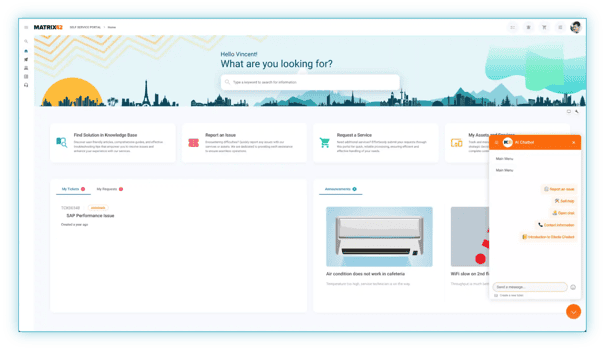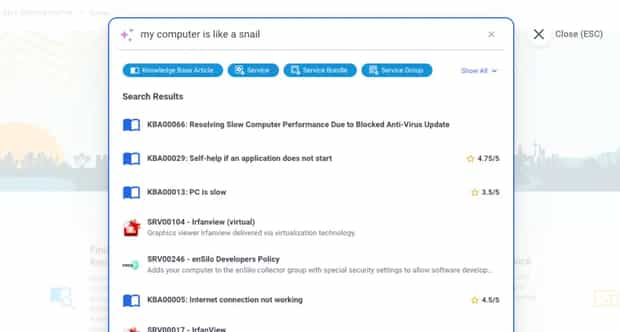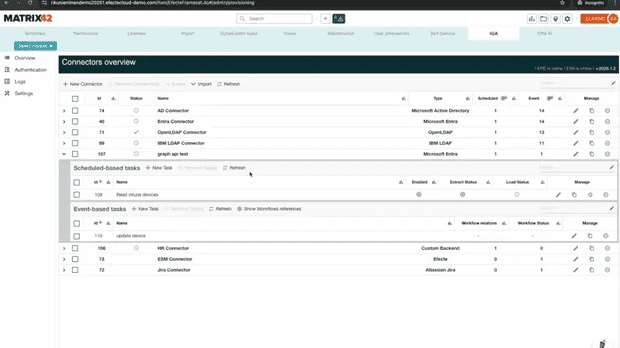What is Enterprise Service Management (ESM)?
Enterprise Service Management (ESM) extends IT Service Management (ITSM) practices to other departments like HR, Finance, and Facilities. It standardizes and automates service delivery, breaking silos and ensuring consistency across the organization.
Introduction
Enterprise Service Management (ESM) leverages IT Service Management (ITSM) principles and applies them to non-IT business functions. This strategic approach enables departments like HR, Finance, Facilities, and more to standardize, automate, and optimize their operations through service management frameworks. The goal is seamless service delivery, operational efficiency, and a superior user experience.
At its core, ESM strives to unify service workflows and introduce structured processes beyond traditional IT. By bridging departmental silos and creating an integrated ecosystem, ESM empowers organizations to transform not just IT, but the entire enterprise.
Example Use-Cases across Functions
Human Resources (HR)
Transforming key HR operations is essential for creating a more efficient and employee-focused workplace. By leveraging automated processes and robust support structures within an Enterprise Service Management (ESM) framework, HR teams can simplify workflows, reduce manual tasks, and deliver faster, more consistent services to employees. This approach not only enhances operational efficiency but also improves the overall employee experience, ensuring HR can focus on strategic initiatives that drive organizational growth and success.
HR Use-Cases:
- Employee onboarding/offboarding automation.
- Self-service portals for updating personal information or benefits enrollment.
- Centralized payroll and leave request management.
Benefits of HR Service Management:
- Improved employee satisfaction.
- Reduction in manual HR tasks.
- Faster onboarding and offboarding cycles.

Contract Management
Efficient contract management is a critical component of Enterprise Service Management (ESM), helping organizations streamline processes and improve overall productivity. By simplifying the creation, tracking, and execution of contracts, businesses can reduce bottlenecks in legal workflows, minimize errors, and ensure compliance with organizational policies. With the right tools and strategies, contract management becomes a seamless part of the broader ESM framework, empowering teams to focus on delivering value while maintaining operational efficiency.
Legal Use-Cases:
- Automate contract lifecycle management (CLM).
- Centralize document storage with secure access controls.
- Enable digital approvals with integrated e-signatures.
Benefits:
- Faster contract creation, review, and approval.
- Improved compliance with legal standards.
- Reduced risk of human error.

Finance
Efficient finance operations are critical for the success of any organization, yet many teams still face challenges like process bottlenecks, manual workflows, and delays that hinder productivity. In the context of Enterprise Service Management (ESM), streamlining finance operations becomes even more essential to ensure seamless collaboration across departments and alignment with organizational goals. By leveraging ESM tools and strategies, businesses can automate repetitive tasks, reduce errors, and eliminate inefficiencies, enabling finance teams to focus on higher-value activities such as strategic planning and decision-making. This creates a more agile and effective finance function that drives overall operational success.
Finance Use-Cases:
- Automate invoice approvals and payment requests.
- Enable shared services, such as audit assistance or tax filings.
- Monitor and manage expense claims via workflows.
Benefits of ESM for Finance:
- Enhanced transparency and accuracy.
- Decreased cycle times for process approvals.
- Improved compliance and audit readiness.

Risk Management
In today's rapidly evolving digital landscape, enhancing organizational resilience and streamlining security workflows are more critical than ever. Enterprise Security Management (ESM) plays a key role in helping organizations proactively identify, manage, and mitigate risks while ensuring seamless coordination across security operations. By integrating advanced tools and scalable frameworks, ESM empowers businesses to adapt to emerging threats, maintain operational continuity, and foster a culture of preparedness. Strengthening these capabilities not only safeguards critical assets but also builds long-term confidence in the organization's ability to navigate complex security challenges.
Risk Management Use-Cases:
- Incident and issue tracking with escalation procedures.
- Ensure data protection with compliance-driven workflows.
- Risk assessment and mitigation planning using analytics.
Benefits:
- Better preparation for regulatory audits.
- Improved transparency in tracking risk exposure.
- Faster resolution of incidents or compliance breaches.

Facilities Management
In the Enterprise Service Management (ESM) context, digitizing support functions is a transformative approach to streamlining operations and maximizing efficiency. By leveraging digital tools and platforms, organizations can optimize the use of physical space and resources, reduce redundant processes, and improve service delivery across departments. This not only enhances productivity but also ensures that support functions like IT, HR, and facilities management are aligned with the broader goals of the organization. Digitization enables better tracking, automation, and management of tasks, ultimately driving value and creating a more agile, responsive enterprise.
Use-Cases:
- Integrate desk booking and maintenance requests into a single system.
- Centralize tracking of building maintenance issues.
- Automate workflows for procurement of office supplies.
Benefits:
- Prolonged asset lifecycle through proactive maintenance.
- Enhanced employee satisfaction with an agile workplace.
- Significant cost efficiencies in resource management.

Frequently Asked Questions
What is the difference between ITSM and ESM?
While IT Service Management (ITSM) focuses solely on managing and delivering IT services within an organization, Enterprise Service Management (ESM) takes these principles a step further. ESM applies the same structured approach to other departments such as Human Resources (HR), Finance, Facilities, and more. By doing so, ESM creates a unified and consistent service management framework across the entire organization, improving efficiency, collaboration, and the overall employee experience. This broader application helps streamline workflows, reduce silos, and ensure a cohesive strategy for delivering services throughout the enterprise
What types of organizations benefit from Enterprise Service Management?
Enterprise Service Management (ESM) offers significant benefits for organizations of all sizes, particularly large enterprises with complex operations and multiple departments. By adopting ESM, businesses can enhance operational efficiency, streamline workflows, and break down silos between teams. This approach improves service delivery, making it faster and more reliable, while aligning service management practices with broader business goals. While large enterprises see the greatest impact, organizations of all sizes and industries can benefit by applying ESM principles, driving collaboration, reducing costs, and delivering value to both employees and customers.
What does ESM do?
ESM, or Enterprise Service Management, extends the principles of IT service management (ITSM) across an organization to improve the efficiency and effectiveness of various business functions. It streamlines workflows, automates repetitive tasks, and fosters collaboration between departments, enabling a unified approach to delivering services with a centralized Service Desk. By centralizing service management practices, ESM helps eliminate silos, enhance communication, and provide a better overall experience for employees and customers alike.
What tools are used for ESM?
Enterprise Service Management (ESM) tools are software solutions that extend the principles and practices of IT Service Management (ITSM) beyond IT departments to other organizational functions. These tools are typically platforms that streamline workflows, automate processes, and enhance service delivery, and integrate to tools across departments such as human resources, finance, facilities, and customer service. ESM tools help organizations boost efficiency, reduce redundancies, and create a seamless experience for employees and customers. Common features used for ESM include self-service portals, workflow automation, reporting and analytics, and integration capabilities with other business systems.
Key Components and Features of ESM

This feature streamlines repetitive tasks like ticket routing, approvals, and escalations, which are often time-consuming and prone to human error. By automating these processes, organizations using Enterprise Service Management (ESM) can significantly improve cycle times and ensure faster resolution of requests. This not only enhances operational efficiency but also boosts employee satisfaction by reducing delays and allowing teams to focus on higher-value tasks. In the ESM context, such automation is critical for managing large volumes of service requests across multiple departments, ensuring consistency, accuracy, and scalability in service delivery.

This feature enables users to resolve issues independently anytime, anywhere, empowering them with the tools and resources to find solutions without needing to rely on the service desk. In the context of Enterprise Service Management (ESM), this is crucial as it not only enhances user satisfaction by providing immediate support but also significantly reduces the workload on the service desk team. By minimizing repetitive queries and freeing up valuable time, service desk staff can focus on more complex, high-priority tasks, improving overall efficiency and productivity across the organization.
.webp?quality=low&width=620&height=350&name=m42-ai-categorization-screencapture%20(1).webp)
AI features like predictive analytics, automated ticketing, virtual assistants, and intelligent routing are revolutionizing service management. They streamline processes by preventing issues, speeding up resolutions, providing instant support, and ensuring accurate ticket assignments. These tools enhance efficiency, reduce delays, and improve customer satisfaction.
%20(1).png?quality=low&width=620&height=350&name=service%20catalogue%20management%20matrix42%20itsm%20(1)%20(1).png)
A centralized repository for all service offerings is a key feature in the Enterprise Service Management (ESM) context because it streamlines the way employees interact with and utilize organizational services. By consolidating all service offerings into one easily accessible location, employees can quickly find the information or support they need without navigating through multiple systems or contacting different departments. This not only improves efficiency but also enhances the user experience by reducing frustration and saving time. Additionally, having a centralized platform simplifies the process of submitting requests, ensuring they are routed to the right team or individual for faster resolution. In the long run, this capability supports better collaboration, improved service delivery, and a more organized approach to managing services across the organization.

Centralized access to critical information provides employees with quick solutions, reducing the time spent searching for resources or waiting for assistance. In the context of Enterprise Service Management (ESM), this capability ensures that employees can easily find the tools, knowledge, and support they need to perform their tasks efficiently. By streamlining access to key information, organizations can improve productivity, enhance employee satisfaction, and ensure consistent service delivery across departments. This feature is especially vital in fostering collaboration and enabling teams to resolve issues faster, ultimately driving better business outcomes.
.webp?quality=low&width=620&height=350&name=dashboard1-screenshot%20(1).webp)
Gain real-time insights into service trends, departmental performance, and areas for improvement to drive better decision-making and optimize operations. In the context of Enterprise Service Management (ESM), having access to this data allows organizations to identify inefficiencies, address bottlenecks, and continuously improve service delivery. By leveraging these insights, businesses can enhance collaboration across departments, ensure resources are allocated effectively, and deliver a more seamless experience for both employees and customers.

APIs enable seamless connections with CRM, HRM, and other business tools, making them essential in the Enterprise Service Management (ESM) context. By integrating these systems, APIs allow for improved data flow and communication across departments, reducing silos and enhancing collaboration. This connectivity ensures that critical information is always accessible, helping organizations streamline workflows, improve decision-making, and deliver consistent, efficient services across the entire business. With APIs, ESM platforms can adapt to the specific needs of an organization, creating a unified digital ecosystem that supports both internal operations and customer-facing processes.
Enterprise Service Management trends
- Automation & Artificial Intelligence
Intelligent virtual assistants and predictive analytics are elevating workflow automation. Tasks such as ticket resolution or knowledge recommendations are now AI-enabled.
- Employee-Centric Solutions
Multi-channel self-service options prioritize ease of use, ensuring employees can access resources 24/7.
- Mobile-First Design
Increasingly, ESM platforms are mobile-compatible, enabling access to services on the go.
- Cross-Functional Collaboration
Tools for real-time collaboration break down barriers between departments, promoting shared workflows.
- Enhanced Security Compliance
With regulations like GDPR, ensuring compliance across every service interaction is critical.

Transform Your Business with Matrix42 Enterprise Service Management
Matrix42's Enterprise Service Management solutions help streamline IT, HR, and business operations by automating tasks, digitalizing processes, and improving efficiency. Key benefits include enhanced efficiency through automation, improved user experience with self-service portals, and scalable solutions tailored to growing business needs.




